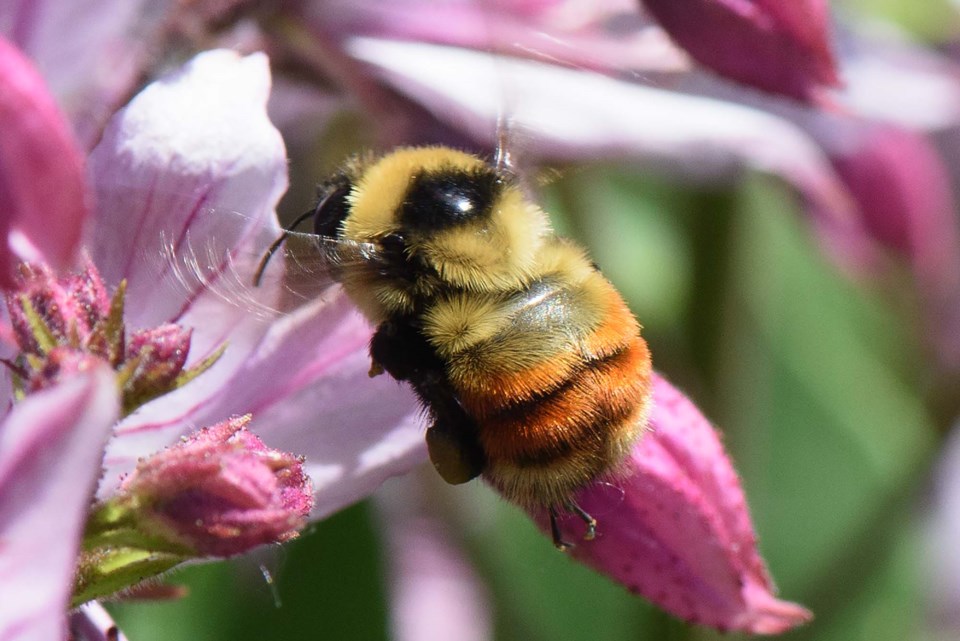Update
Payton Homeak told the Gazette June 9 that she was mistaken when she said the Botanic Park bee lecture was on July 22. It is in fact on July 23 from 10 a.m. to 1 p.m. This article has been updated to reflect this information.
St. Albert residents will learn to build bumblebee bungalows this summer as the city steps up its plans to protect native bees.
The City of St. Albert will hold three free and paid events this summer to teach people about the importance of native bees.
City crews had expressed an interest in putting honeybee hives atop city buildings to produce honey and raise awareness of the importance of pollinators, said Melissa Logan, the city’s environmental co-ordinator for the Sturgeon River and natural areas. Since honeybees are an introduced species, she suggested the city instead focus on native bees, some of which are at risk in Alberta.
Logan said the city has brought in Samantha Morrice of the Alberta Native Bee Council to run three bee education events in St. Albert this summer.
The first is a workshop for city staff and the Big Lake Environment Support Society’s Summer Nature Centre co-ordinator to learn more about native bees so they can use those lessons in other city programs.
Next is a bumblebee hotel workshop at the Grey Nuns White Spruce Park on June 24. Logan said up to 30 people will get to participate in this paid event, where they will learn about bumblebee identification and build a bee hotel.
Morrice said the Alberta Native Bee Council encourages people to build and monitor bee hotels to help track bee populations and spot rare species. Solitary bee hotels consist of holes drilled in wood or paper straws, and have to be cleaned with bleach every year. The bumblebee hotels she will demonstrate on June 24 are basically birdhouses with raw cotton in them, and are easier to maintain.
Last is a free native bee lecture at the St. Albert Botanic Park on July 23. About 30 guests will learn how to identify St. Albert’s native bees and head out into the garden with nets and jars to try and catch some of them, Logan said.
Busy bees
There are 375 known species of wild bee in Alberta, or about 42 per cent of the bee species in Canada, reports the Alberta Native Bee Council.
“They are one of the most efficient pollinators of any insect,” Morrice said, and are vital for the health of wild flowers and commercial crops.
There are probably about a hundred native bee species in the Edmonton region, but it’s hard to say for sure, as there aren’t many regional population lists for this area, said Matthias Buck, assistant curator of invertebrate zoology at the Royal Alberta Museum. Many are only active at specific times of the year.
Buck said Edmonton-area residents will likely see a lot of mining bees buzzing about this month. Mining bees are a huge family of solitary, ground-nesting bees that are often dark, black, and non-descript, the Alberta Native Bee Council reports. Buck said residents are most likely to encounter the Milwaukee miner bee, which is smaller than a honeybee and covered with fiery red hair.
The Gazette has often seen bumblebees with white or orange stripes on their bodies around St. Albert.
Buck said the white-striped ones are likely cryptic bumblebees, which used to be called white-tailed bumblebees. Often confused with two other white-tailed species in Alberta (hence the name), the cryptic bumblebee first arrived in the Edmonton region a decade ago and has since thrived. The red-striped ones are likely red-belted or tricoloured bumblebees.
While bees can often be identified by their appearance, Buck said many species have nearly identical colour patterns and can be challenging to tell apart. He recommends using a guidebook or experts at inaturalist.ca to help.
Residents can sign up for the bee workshops by visiting stalbert.ca/bees.




